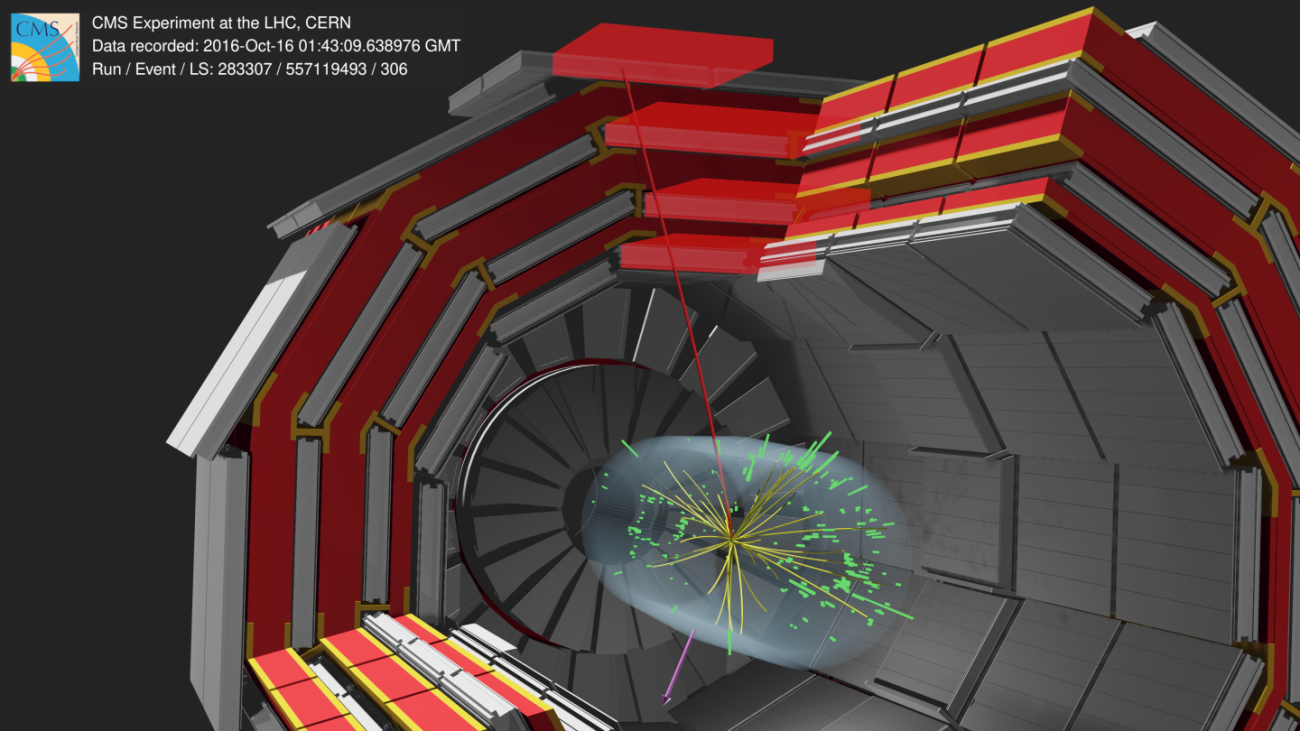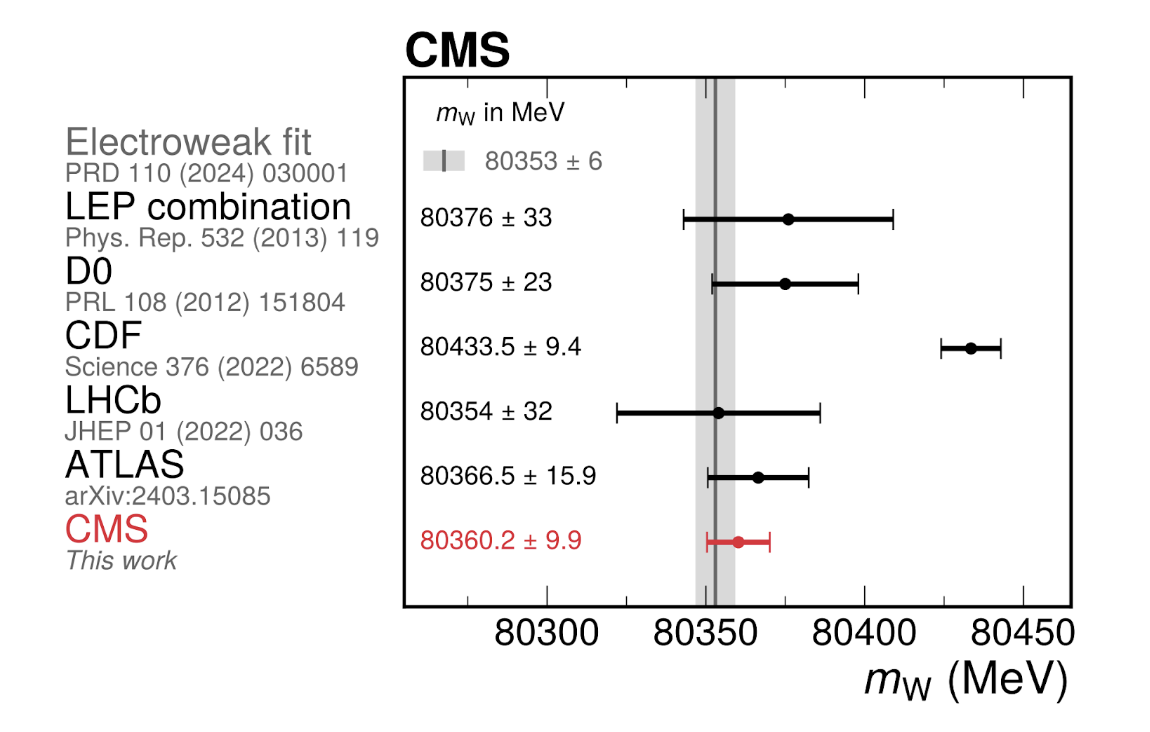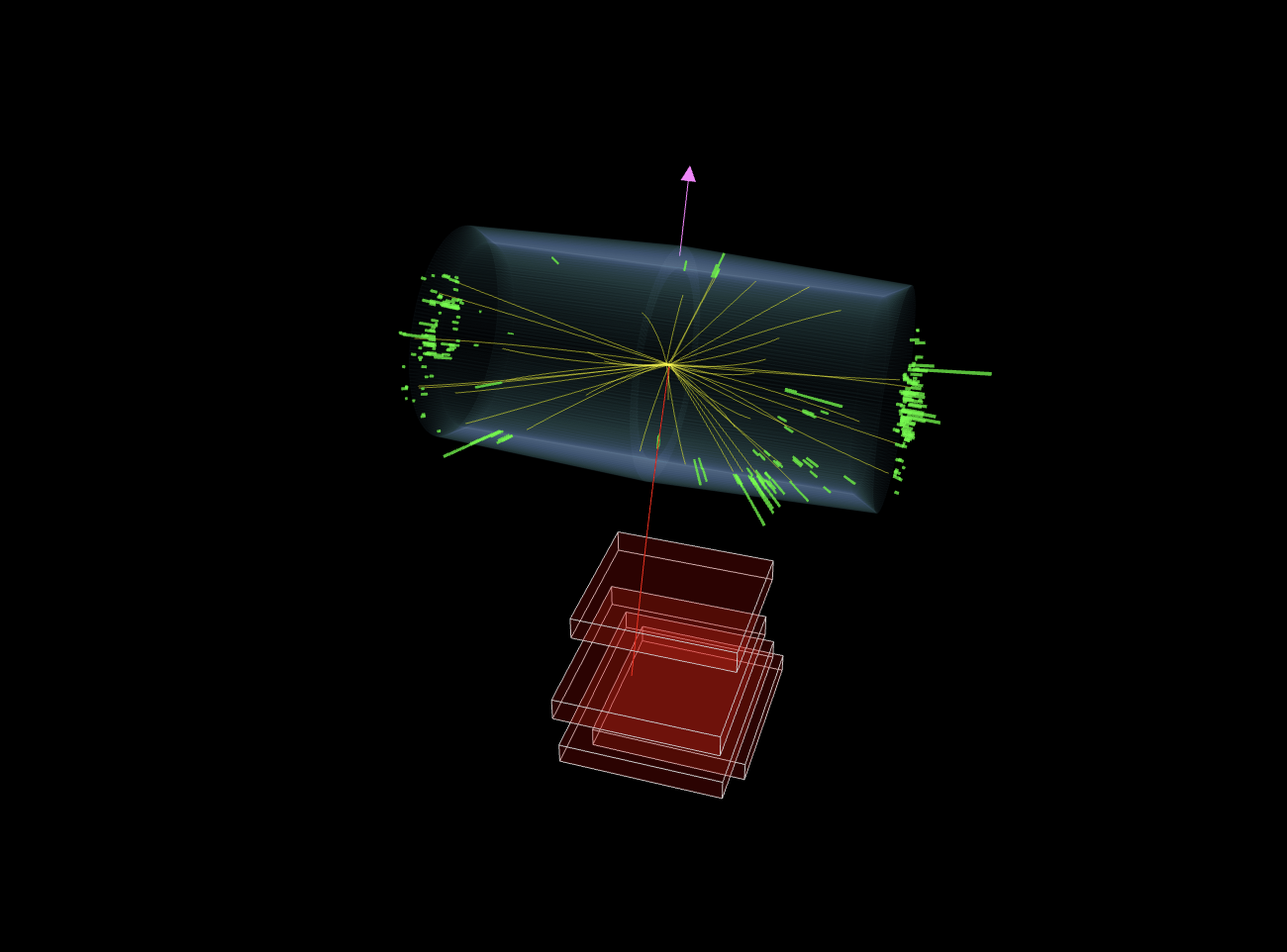CMS Achieves LHC's Most Precise W boson Mass Measurement Yet

The first measurement of the W boson mass (mw) performed by the CMS Collaboration was announced in September 2024. This result has been long-awaited—the first LHC measurement of mW, by the ATLAS Collaboration, was shown nearly 7 years ago. In the meantime, the CDF Collaboration at the Fermilab Tevatron published a surprising discrepancy between their mW measurement and the expectation within the framework of the Standard Model (SM). Following this, many eyes in the particle physics community turned anxiously to the CMS Collaboration. It was well known that an analysis team had already been working on the measurement for several years, making it the best candidate to produce a new result that could shed light on the discrepancy seen by the CDF Collaboration. While the new result has perhaps extinguished the excitement of beyond the Standard Model physics suggested by the CDF Collaboration result, the precision of the measurement is a triumph in the effort to perform precise measurements of fundamental parameters at the LHC.
Although explaining the hierarchy of particle masses is a goal of many theoretical extensions of the SM, in the SM itself, particle masses must be measured and input to the theory. However, the SM predicts interactions between many fundamental particles that lead to interdependencies in such experimental parameters. In the SM, the expected value of mw can be inferred from other measurements, including the fine structure constant, the fermi coupling constant, and the masses of the Z boson, the top quark, and the Higgs boson. Combining these measured values with the expected SM relationship yields an expected value of mw = 80,353 ± 6 MeV. However, heavy particles with electroweak interactions that have not yet been observed would modify this relationship. As such, comparing this expectation to the direct measurement of mw provides a test of the SM that is sensitive to beyond-the-SM effects.
The Z boson mass has been measured with exceptional precision through resonant Z boson production in precise beam energy scans at LEP. The LEP-only measurement yielded a mass of 91.1876 ± 0.0021 MeV (corresponding to a precision of about 23 parts per million), while the current PDG average, which combines results from LEP and CDF, is 91,188.0 ± 2.0 MeV. The mw measurement at LEP was based on the direct reconstruction of pair-produced W bosons, which has a production rate in electron-positron collisions several orders of magnitude lower than that of Z boson production, achieving much lower precision than the mz measurement. Subsequent measurements performed at Fermilab's Tevatron and the LHC contributed to the current experimental average of mw = 80,369.2 ± 13.3 MeV.
The CMS Collaboration has achieved a significant milestone in precision physics, reporting in a recent publication the most precise measurement to date of the W boson mass at the LHC: 80,360.2 ± 9.9 MeV. This value is in agreement with the prediction from the SM, reinforcing the model's consistency while matching the remarkable precision of the CDF experiment's recent measurement.

Experimental results for the mass of the W boson. The grey band represents the uncertainty on the value of the Standard Model. The CMS result is highlighted in red, and agrees with the mass expected from the Standard Model with very high precision.
Measuring the W boson mass with such precision in the complex LHC environment is no small feat. Because the W boson has a very short lifetime, its mass is inferred by its decay products. At hadron colliders, the quark-antiquark decay of the W boson cannot be measured and calibrated to sufficient precision. Therefore, measurements rely on the decay of the W boson to a lepton and a neutrino. Neutrinos, which interact weakly with matter, are not directly measurable at hadron colliders. Instead, their momentum is estimated through the conservation of momentum by measuring all detected particles. The CMS measurement was conducted using data collected in 2016 during proton-proton collisions at a center-of-mass energy of 13 TeV. One of the primary challenges lies in the multiple simultaneous collisions per event (pileup), which generate additional particles that can obscure the signals from the W boson's decay, and in particular, the neutrino. The CMS team successfully navigated this challenge by focusing the measurement on the charged lepton from the W boson’s decay, specifically selecting muons, which can be identified and calibrated most easily in CMS. Because the full decay products of the W boson are not reconstructed, the measurement is sensitive to the motion of the W boson itself. This dependence is controlled by incorporating state-of-the-art theoretical models, which, combined with advanced analysis and calibration techniques, enable a highly precise result.
The calibration of the muon momentum scale was based exclusively on J/ψ → μμ events, with Υ(1S) and Z boson decays reserved for validation. By using the well-known mass of the J/ψ resonance combined with a detailed model of muons' interaction with the detectors, the researchers achieved an absolute calibration of the muon scale across the full kinematic range relevant to the W boson mass measurement. This calibration strategy ensured that the measurement remained unbiased and independent of the Z boson mass, allowing the Z boson mass measurement to serve as a rigorous cross check of the calibration.
To handle uncertainties related to higher-order QCD and electroweak corrections, the team integrated Theory Nuisance Parameters (TNP)—an innovation developed by the theoretical community—for the first time in a measurement. These parameters were embedded into the fit to minimize theoretical biases without relying on assumptions about correlations between Z and W boson production. Combined with state-of-the-art calculations to model the transverse momentum distribution of the W boson with N3LL + NNLO precision from SCETlib+DYTurbo, the TNPs serve to parameterise the effects of missing higher-order corrections. This approach allowed researchers to constrain these uncertainties directly from the data and represents a valuable improvement in handling theoretical uncertainties, particularly important for precision measurements in the high-luminosity era of the LHC.
To validate the methodology, researchers applied the same analysis to Z boson decays by considering one muon and treating the other as a neutrino. The measured Z boson mass matched the established value with remarkable precision, confirming the robustness of the technique. Additionally, an alternative analysis procedure was developed, which relaxed some theoretical assumptions. The resulting mW value was consistent with the primary measurement, providing an additional layer of confidence.

A W boson candidate event seen in the CMS detector as part of the measurement of the mass of the W boson. In this event, a candidate W boson is produced, which decays into a muon and a neutrino (not seen). The muon is represented by the red line. The missing transverse momentum due to the neutrino is represented by the pink arrow. The display is interactive and can also be viewed on a separate page here.
The large data set was also exploited to reduce the impact of parton distribution functions (PDFs) that describe the motion of quarks and gluons inside the colliding protons. To rigorously assess the stability of the measurement with respect to the chosen PDF set, the researchers systematically varied the chosen PDF set and repeated the fit for each. The extracted W boson mass remained remarkably stable across these variations, demonstrating the robustness of the measurement against PDF-related uncertainties. The final uncertainty attributed to PDF variations was found to be only 4.4 MeV, a significant achievement given the complexity of hadron collider environments.
The CMS result contrasts with the recent CDF measurement, which reported a mass significantly higher than the expectation from the SM. The CMS measurement, obtained with comparable precision, supports the SM, suggesting that the CDF discrepancy might stem from experimental or methodological differences.
This groundbreaking result demonstrates the power of the CMS detector and the power of innovative analysis approaches. As LHC experiments continue with increased luminosity and upgraded detectors, the precision of measurements like these will only improve, providing deeper insights into the fundamental forces of nature.
The CMS Collaboration's achievement not only strengthens the foundations of the Standard Model but also showcases the capabilities of precision physics at the LHC—which offer an unforeseen path to discoveries.
